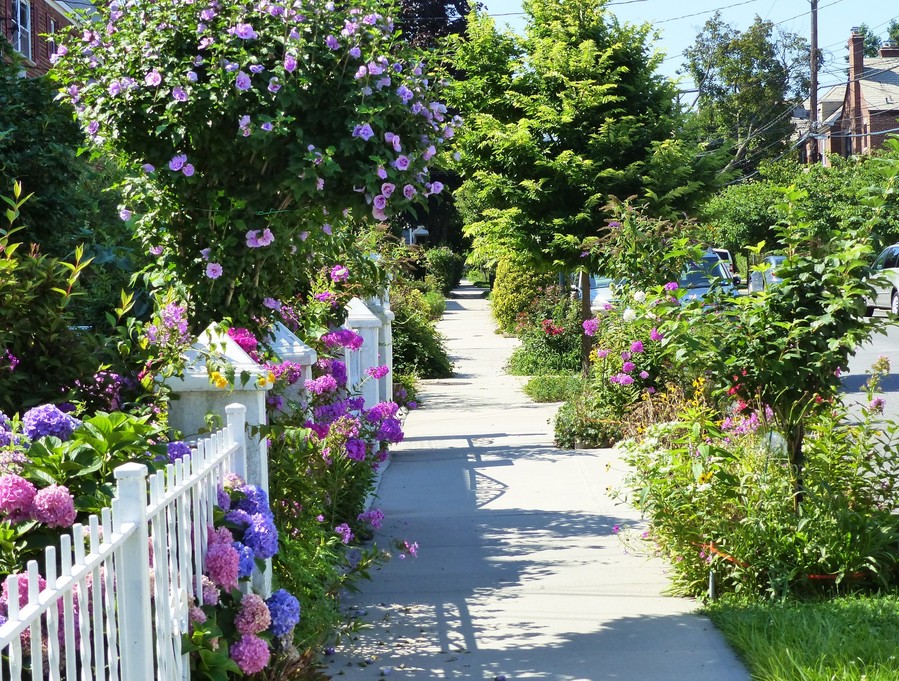Streets of North Riverdale have their own sparkle
Constitutionals are a great way to stay on top of what is new and creative in your neighborhood.
One of my favorite areas is North Riverdale, by which I mean the blocks bounded by Broadway, Mosholu Avenue, Riverdale Avenue and West 263rd Street. It’s an area of private homes with front yards, tree pits and lawn panels — which is the term for the grassy area between the sidewalk and the roadway. Gardening lawn panels is a way to add special charm, and those streets that appeal most have flowers and plants that continue into the lawn panels.
There are three locations in North Riverdale that I would like to cite. These locations have gardened the lawn panels of consecutive houses. The first spot is the block of Liebig Avenue from West 259th Street to Mosholu Avenue on the east side of the street, particularly those houses closest to West 259th.
In years past, the first flowers that struck me were tall, dainty cosmos in shades of lavender and fuchsia. This year I saw few cosmos, but they were replaced by blue-purple hydrangeas coupled with phlox and Rose of Sharon. Other plants include rudbekia, buddleia, Snow on the Mountain (Euphorbia marginata), and the vincas that resemble impatiens.
In fact, I misidentified the plants first as the standard impatiens, then as the New Guinea impatiens, and was corrected by a neighbor.
The old colorful standard impatiens is Impatiens walleriana (from the family Balsaminaceae) otherwise known as “Busy Lizzie,” which has been decimated by downy mildew – Plasmopara obducens. This is an airborne fungus whose spores can overwinter in the soil or can be spread by ejection from a water splash.
The spores can persist for up to five years in the soil, so if you have had an infestation, do not try that spot again for years. Impatiens walleriana, of east African origin, has been the go-to plant for shady areas that require color.
The New Guinea impatiens, also Balsaminaceae, are Impatiens hawker, and they are not susceptible to downy mildew. They were collected in Papua, New Guinea, by nurse Lt. Hawker — hence the epithet — in 1884, but were only introduced to the United States in the early 1970s. They also are excellent plants for shade.
Finally, there is annual vinca — Catharanthus roseus of the family Apocynaceae — from Madagascar. It closely resembles the New Guinea impatiens, but the tip-off is that it grows in strong sunlight.
I asked one of the neighbors if they make joint decisions to create a unified garden. She said that each neighbor works individually, but that they exchange information and learn from each other.
The second location on my list is the block on Fieldston Road between West 259th and Mosholu. Again, several lawn panels were planted, although here most of the plants are annuals, particularly marigolds.
While not caring for the scent of most marigolds, I am continually amazed by the range of flower types in the most marvelous tones of orange, yellow and tangerine.
The compound lutein from one species of marigold is used as a food coloring in Europe, but only in poultry feed in the United States. They are part of the Asteraceae family, which includes daisies and sunflowers.
The genus is Tagetes, derived from an Etruscan mythological figure named Tages who sprang to life out of a plowed furrow. The name may reference the fact marigold seeds readily germinate from seeds produced by the previous year and thereby seemingly leap forth from the soil.
The name “marigold” is a contraction of “Mary’s” — referring to the Virgin Mary — and the color gold. It may refer to using the flower as an offering in place of gold coins.
Marigolds are culturally important in India, Nepal, Thailand and Mexico.
I only recently stumbled on my third location at West 260th Street and Post Road. Trumpet vines are beautiful, but very invasive. We inherited one, and we were quickly advised to try to get rid of it, and it was almost impossible to do.
The little spot I found had a beautiful red trumpet vine (Campsis radicans) planted in a tree pit. It has grown so luxuriantly that it forms an arch over the sidewalk .
It belongs to the Bignoniaceae famil,y and the only plants I could find that I recognized from that family was the jacaranda and catalpa trees. It seems to be a native of the Ozarks, but has naturalized extensively.
The “Campsis” part of the name derives from the Greek kampe — something bent — referring to the stamens and radicans, indicating it has roots growing out of the stems which help it climb. One of its saving graces is that it attracts hummingbirds.
Indeed, treasures are all around us!






